#Gospel of St. Luke
Explore tagged Tumblr posts
Text

“Hail, full of grace, the Lord is with thee: blessed art thou among women.”
Lk. 1:28 Douay-Rheims Bible
Artwork: Luis Juárez (Mexican, 1585-1639) The Annunciation (before 1638).
#catholicism#douay rheims bible#Luis Juárez#Blessed Mother Mary#archangel gabriel#annunciation#gospel of st. Luke#new testament#religious paintings#Full of grace#Immaculate Conception#BVM#sacred scripture
10 notes
·
View notes
Text
Links to Gospels below:
Gospel According to Matthew
Gospel According to Mark
Gospel According to Luke
Gospel According to John
*not adding Acts of the Apostles b/c it's after Jesus' Resurrection
#catholic#bible#christianity#catholicism#roman catholic#roman catholicism#matthew#st matthew#mark#st mark#luke#st luke#john#st john#st matthew the evangelist#st mark the evangelist#st luke the evangelist#st john the evangelist#gospel#gospel of matthew#gospel of mark#gospel of luke#gospel of john
100 notes
·
View notes
Text

October 18 is the Feast Day of St Luke. He appears here at the start of the Gospel that bears his name in the Evangelium of Judith of Flanders (Cantorbéry, 1065). The Morgan Library & Museum, New York, ms M.709, f° 77v, 29,3 × 19,1 cm. :: [Robert Scott Horton]
* * * *
Night Surrender to Praise at Dawn – Nov. 16, 2021
“In the middle of the night I hold hands with trust and surrender to the One who sees without a light… My prayer travels deep into my soul space, into the essence of my being.
Rising from sleep, I raise high the chalice of my life. Dressed in robes of joyful anticipation, I enter this day with an open heart. This is the awakening hour. This is the hour of praise. ‘O medicine of dawn; O healing drink of morning!’ Offering both words and silence, I join in the dance of creation.”
–Macrina Wiederkehr, Seven Sacred Pauses: Living Mindfully Through the Hours of the Day, p. 29 and 47
[alive on all channels]
#Robert Scott Horton#St. Luke#The Morgan Library & Museum#Gospel of Luke#Night Surrender to Praise at Dawn#Macrina Wiederkehr#prayers#alive on all channels#quotes
11 notes
·
View notes
Text
St. Luke the Evangelist - Healer, Historian, Iconographer
This blog post offers a comprehensive exploration of the life and significance of Saint Luke the Evangelist. It delves into his diverse roles as a healer, historian, and iconographer, shedding light on his contributions to early Christian literature and.
In the name of God the Father, Christ Jesus His Son and the Holy Spirit, One True God. Amen Dear brothers and sisters in Christ Jesus IntroductionLife and MinistryNew Testament ReferencesGospel of LukeThe Universal SaviorParables of Mercy and ForgivenessThe Good SamaritanThe Ministry of HealingWomen in Luke’s GospelLuke – As a HistorianLuke – As an Artist Introduction On October 18, the…
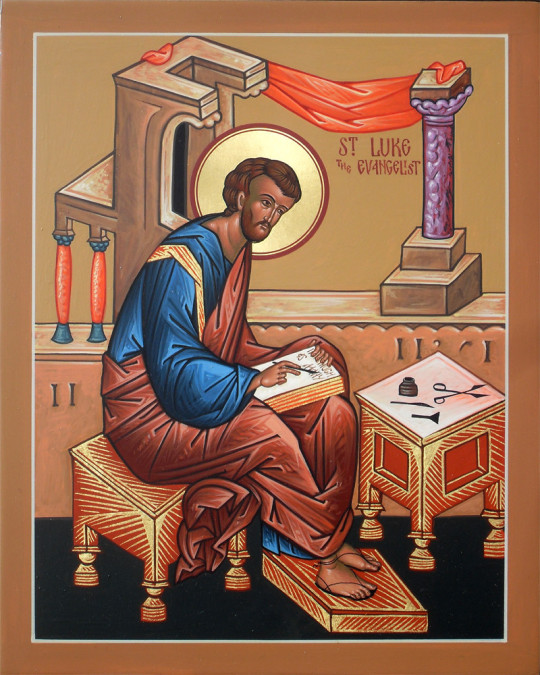
View On WordPress
#Acts of the Apostles#Early Christian Literature#featured#Good Samaritan Parable#Gospel Authorship Traditions#Gospel of Luke#Iconography in Orthodox Christianity#Indian Orthodox Church#Luke the Physician#Luke&039;s Education and Background#Ministry of Healing Women in Luke&039;s Gospel#New Testament References to Luke#Orthodox faith#Parables of Mercy#Prodigal Son Parable#St. Luke as a Historian#St. Luke as an Artist#St. Luke the Evangelist#St. Luke&039;s Contribution to Christian Faith#St. Luke&039;s Gospel Themes#St. Luke&039;s Legacy in Christian Art and Writing#St. Luke&039;s Relationship with Apostle Paul
0 notes
Text
#OH THAT WOULD BE COOL AS SHIT#i was raised Christian (babtist) but I’m? entirely unfamiliar with the concept of like#the 4 evangelicalists#but just the idea of a monsterous creature#previously separate entities#merged into one being over grand amounts of time#while the lines between their original ideals and modern times become blurred#v cool#maybe INSPIRED by Christianity but from what i understand a separate concept overall#reboggle
@spotty-is-slumberous
Yes! You get it!
With very few exceptions I'm not a fan of Christian coding or Christian imagery in my religious feral cat fiction, but you know what would kick ass? The founders being merged into a single cherub-like entity (so winged and four heads: lion, eagle, bull, and human).
#and for reference: the 4 evangelists are the ones who wrote the 4 gospels#the books of the Bible that tell the life of Jesus from 4 alternate perspectives#St. Matthew#St. Mark#St. John#and St. Luke
23 notes
·
View notes
Text

Christ and St Mary Magdalen at the Tomb
Artist: Rembrandt van Rijn (Dutch, 1606-1669)
Date: 1638
Medium: Oil on Panel
Collection: Royal Collection Trust, United Kingdom
Description
Christ and St Mary Magdalene at the Tomb reveals how imaginatively Rembrandt could interpret traditional religious subject-matter. The scriptural source for this scene is the Gospel of St John (20:11-18), who describes in some detail the burial and subsequent resurrection of Christ following the Crucifixion. Mary Magdalene returns to the tomb early the next morning, only to find the stone at the entrance removed and two angels inside it where the body should have been. She then fetches two of the disciples, who check that the tomb is empty and then leave her. The angels then ask Mary Magdalene, ‘Woman, why weepest thou?’ and she replies, ‘Because they have taken away my Lord, and I know not where they have laid him.’ At that moment she turns round and sees a man dressed as a gardener, not appreciating that he is the resurrected Christ. She appeals to him for information, but he calls her by her name and she instantly recognises him. (‘Jesus saith unto her, Mary. She turned herself, and saith unto him, Rabboni; which is to say master.’) Rembrandt has depicted the moment of realisation just before the actual recognition. Most artists chose to paint the next moment in the text, when Mary Magdalene reaches out towards Jesus and he forestalls her with the words ‘Touch me not’ (in Latin, Noli me tangere).
Rembrandt skilfully evokes the dawn as the opalescent light picks out from the darkness the towers of the Temple of Jerusalem, the upper half of the figure of Christ, the face of Mary Magdalene, and the outline of one of the angels in the tomb. This use of light is almost symbolic in both the physical and the spiritual senses. The paint is in general thinly applied and, apart from the treatment of the light and the vegetation around the tomb referring to Christ’s activities as a gardener, could almost be described as monochrome. It is only after a time that the eye focuses on the two female figures (the Gospels of St Mark and St Luke refer to three Maries at the tomb) in the middle distance on the left descending the hill.
Of particular note is the positioning of Christ, who in the relationship established between his partially silhouetted vertical form and the Temple of Jerusalem behind and the rocky cave next to him dominates the composition, whereas the twisting pose of Mary Magdalene is the pivot. The tension created between Christ’s standing figure and the twisting kneeling Mary Magdalene is palpable. The artist’s only other treatment of the subject of Christ and Mary Magdalene is in Brunswick (Herzog Anton Ulrich Museum): it is dated 1651 and is totally different in composition.
#oil on panel#rembrant van rijn#christ#mary magdalene#angels#tomb#christianity#holy bible#gospel of john#bible scene#biblical#dutch painter#landscape#temple#jerusalem#architecture#foliage#17th century painting#european art
60 notes
·
View notes
Text
Reading the Ancient Magic Book Pages
I propose to you today a short analysis of the sections of text on the pages of the Ancient Magic book we find below the restricted section.
High-res images of the book’s pages have been shared by a kind soul. Here they all are:
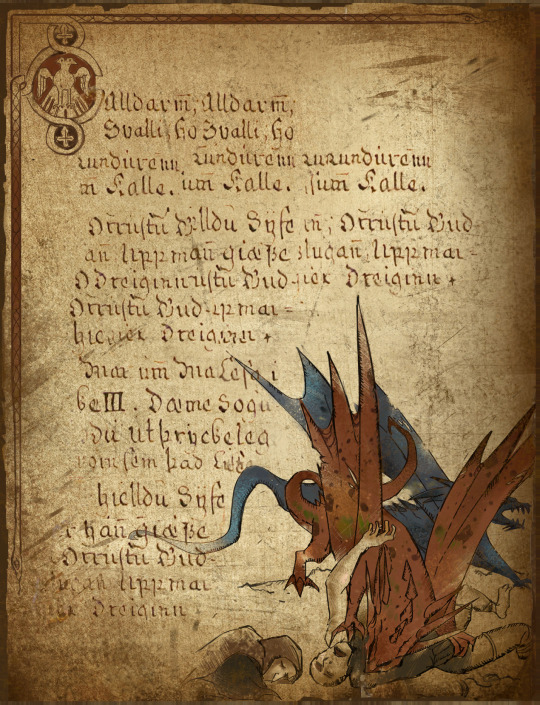
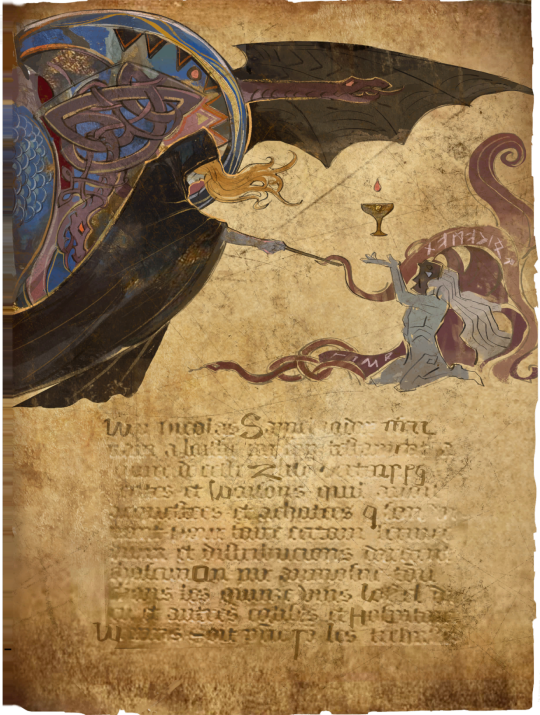


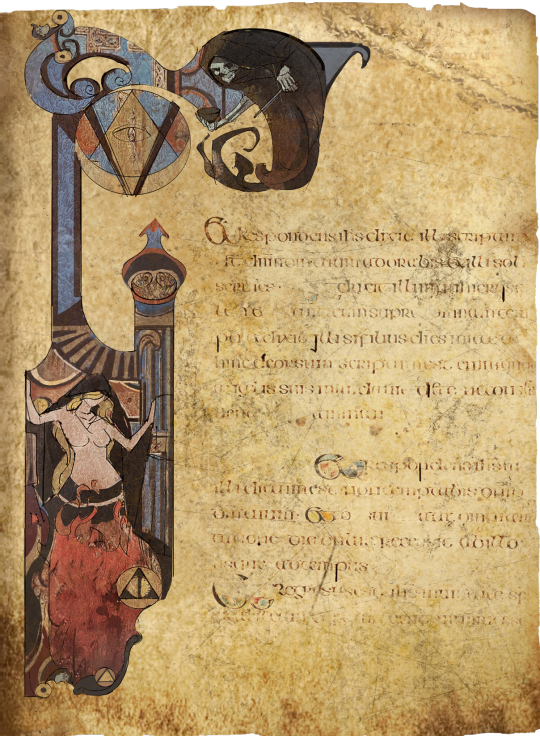
I was working on a completely different post when I realised that the text on the last 2 pages was easily readable and written in Latin. So I just did a quick search and discovered that these are verses from the Vulgate (4th century translation of the Bible in Latin), more precisely from the Gospel of Luke from the New Testament.
A bit more research and I could find exactly which source they got this text from: the Book of Kells, a Celtic Gospel book written in Latin and illuminated in the Insular style (a combination of Celtic and Anglo-Saxon styles). The precise origins of the Book of Kells are debated but many believe it was created around the year 800 at the monastery founded by St Colum Cille on Iona Island in western Scotland.
Here I put side by side the pages of the Ancient Magic book and the pages from the Books of Kells where the text is from (folio 204r and 275r):

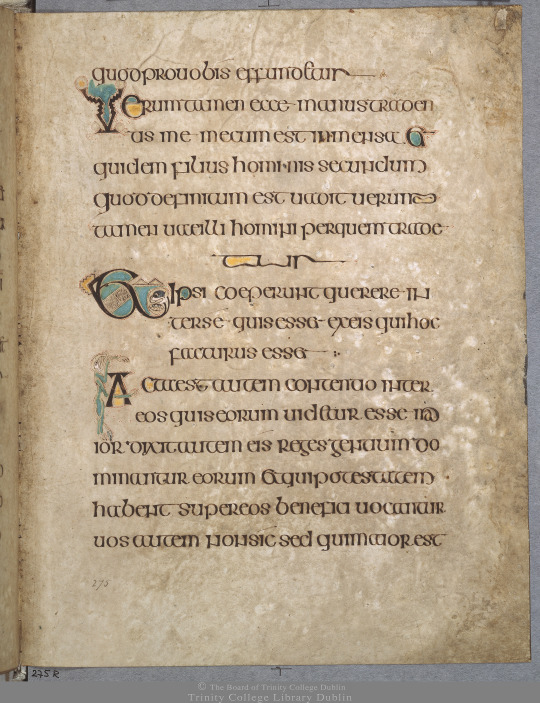

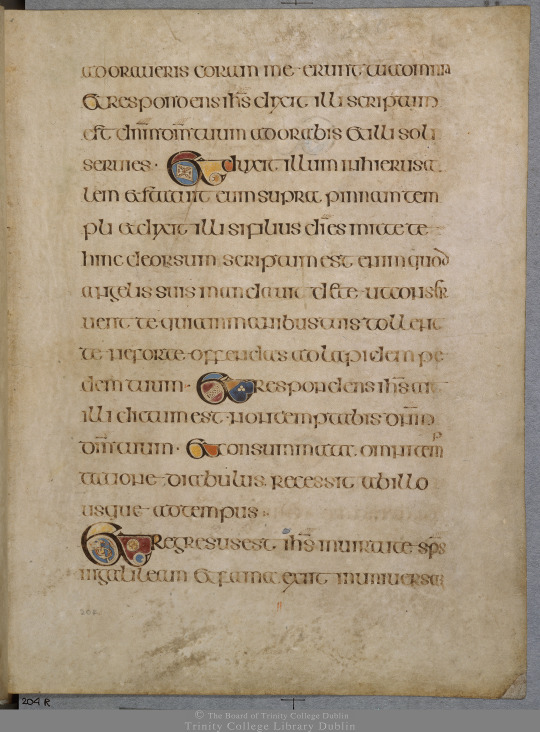
The verses they used are Luke 22:23
Et ipsi coeperunt quaerere inter se quis esset ex eis qui hoc facturus esset.
Which translates to:
And they began to enquire among themselves, which of them it was that should do this thing.
And on the second page, Luke 4:8-14
Et respondens Jesus, dixit illi: Scriptum est: Dominum Deum tuum adorabis, et illi soli servies. Et duxit illum in Jerusalem, et statuit eum super pinnam templi, et dixit illi: Si Filius Dei es, mitte te hinc deorsum. Scriptum est enim quod angelis suis mandavit de te, ut conservent te: et quia in manibus tollent te, ne forte offendas ad lapidem pedem tuum. Et respondens Jesus, ait illi: Dictum est: Non tentabis Dominum Deum tuum. Et consummata omni tentatione, diabolus recessit ab illo, usque ad tempus. Et regressus est Jesus in virtute Spiritus in Galilaeam, et fama exiit per universam regionem de illo.
Which translates to:
And Jesus answered and said unto him, Get thee behind me, Satan: for it is written, Thou shalt worship the Lord thy God, and him only shalt thou serve. And he brought him to Jerusalem, and set him on a pinnacle of the temple, and said unto him, If thou be the Son of God, cast thyself down from hence: For it is written, He shall give his angels charge over thee, to keep thee: And in their hands they shall bear thee up, lest at any time thou dash thy foot against a stone. And Jesus answering said unto him, It is said, Thou shalt not tempt the Lord thy God. And when the devil had ended all the temptation, he departed from him for a season. And Jesus returned in the power of the Spirit into Galilee: and there went out a fame of him through all the region round about.
I’m not christian and don’t know much about the Bible so I have no idea why they chose these particular verses. Maybe someone more educated than me will be able to chime in. My hunch is that these verses were just chosen at random from old manuscripts that the artists for the game were using as reference for the art style.
Now, since I was on a roll, I also looked at the text on the other pages. Pages 1 and 3 have some text written in some old form of Icelandic (figured that out from the few words I could sort of read on those pages). So I started looking into old Icelandic manuscripts but it took me a ridiculously long time to find the exact source the text is from! I was starting to go mad but here it is! It’s from an illustration of the Prose Edda found in the Icelandic manuscript ÍB 299 4to., in particular the illustration of the god Týr presented as Mars (folio 60r).
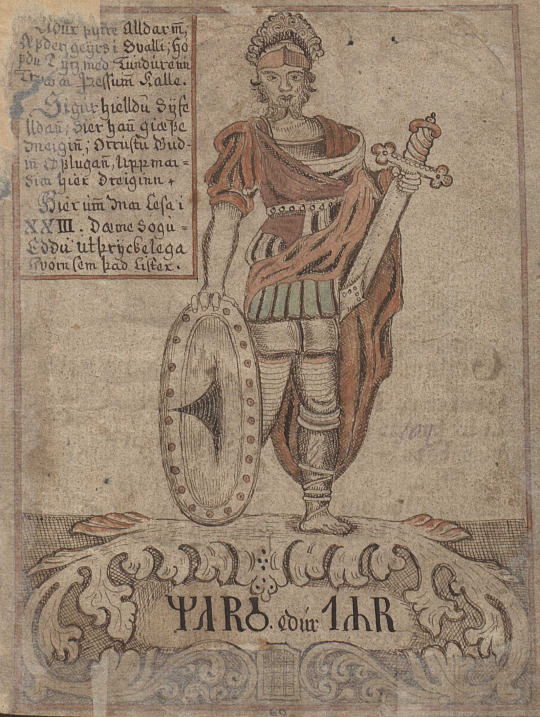


They took the short text in the little box and copy/pasted it mosaic style to give the illusion of the full page of text but you can see it’s just short sections that repeat over and over on both pages.
(To note: this manuscript is from 1764 so it’s sort of anachronistic for them to use this source for an Ancient Magic book that already existed in the Keepers time, meaning the Ancient Magic book is from the 15th century or older.)
Týr is one of the principal war gods in Norse mythology (alongside Odin and Thor) but he also presides over justice and the law. Latin texts often identified him as Mars (hence the subject of the illustration).
I could not find any transcription or translation of the text on the image, I could only decipher some words here and there such as «sigir hielldu» which google translate tells me could mean «victories held» in Icelandic. A bit further down there is «orrustu guð» which could mean «god of war». So it seems to be a short description of the god Týr and at the end there are roman numerals that identify the section in the Prose Edda where the story of Týr can be found.
Again, I can’t really see how this text makes particular sense in the context of the Ancient Magic book, probably just placeholder text from some of the sources they were studying as inspiration.
There is one last book page, but the text on this one is so blurred I didn’t even try to decipher it. Although I do note that the artist has traced over some letters which are: W S M I(?) I(?) I(?) Z N R(?) P(?) G W Q O U(?) H W R(?)

Don’t know… some of them are hard to read or could be not from the Latin alphabet. Again, I just can’t make sense of that. There are not enough vowels for it to be an anagram of an English or Latin phrase so… what else? I leave this mystery to others with more powerful brains than mine!
Anyway, this is it! Not really much to say about this but I think other people are also planning on looking into these book pages so maybe these findings can help them out!
98 notes
·
View notes
Text
me on my birthday: what does it mean to still be alive. am I wasting my life.
my prayer book: it's the feast of st. luke. the divine physician gives you life. medication is a gift. writing is an act of love. devote your life instead of obsessing about it.
my mother 23 years ago reading the gospel of st. luke, the only gospel that includes joanna in the list of women at the tomb: this has enough mourning and hope and preaching for my eldest daughter's name
my grandma when I asked her why I feel so weird: you never imagined being brave enough to have the life you do. but god did not create you to live a shadow of a life
#grateful to be here and for all of you 💞💞#if birthdays are weird for you make sure to look outward as well as inward#see ecclestiastes 38 if you feel weird about taking any kind of medication btw#*ECCLESIATICUS (SIRACH) 38. typo alert
113 notes
·
View notes
Text

Happy Feast Day
Saint Luke the Evangelist
Died: 85
Feast day: October 18
Patronage: artists, bachelors, bookbinders, brewers, butchers, doctors, glassworkers, goldsmiths, notaries
Saint Luke, an early convert of paganism to Christianity, was a physician who was born in Antioch, Syria. Luke was a close companion of St. Paul, whom he accompanied in prison on two different occasions. St. Luke is the writer of the third Gospel and the Acts of the Apostles; his account of events is firsthand history
Prints, plaques & holy cards available for purchase. (website)
70 notes
·
View notes
Text

"And going up to him, bound up his wounds, pouring in oil and wine: and setting him upon his own beast, brought him to an inn, and took care of him."
Gospel According to St Luke 10:34 Douay-Rheims Bible.
Artwork: Cyprián Majerník, The Good Samaritan (1940).
#Catholicism#Jesus#Gospel of St. Luke#Cyprián Majerník#artwork#new testament#douay rheims bible#good samaritan
3 notes
·
View notes
Text
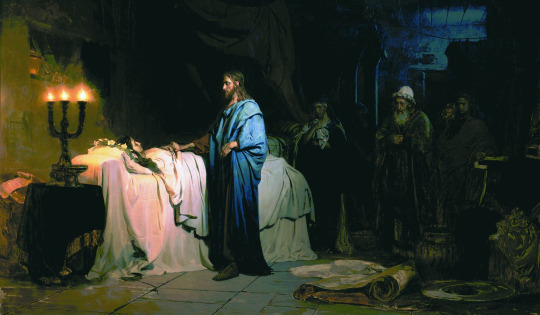
Ilya Yefimovich Repin (Ukrainian-born Russian) Resurrection of Jairus' daughter, 1871 State Russian Museum, St. Petersburg The raising of Jairus' daughter is a reported miracle of Jesus that occurs in the synoptic Gospels, where it is interwoven with the account of the healing of a bleeding woman. The narratives can be found in Mark 5:21–43, Matthew 9:18–26 and Luke 8:40–56.
#Ilya Yefimovich Repin#Resurrection of Jairus' daughter#christian art#christian#christianity#christentum#russian art#russia#ukraine#art#fine art#european art#classical art#europe#european#oil painting#fine arts#europa#catholic#israel#Jesus Christ#Jesus#bible#orthodox#anglican
224 notes
·
View notes
Note
Michael the Archangel barely shows up in the Bible itself, most information about him comes from sacred tradition. The Catholic Church specifically really reveres him (as Saint Michael, of course). Restorationist Christians tried to come up with alternate theories for who Michael is. Michael means “who is like God,” usually interpreted as a rhetorical question (nobody is like God). In Catholic sacred tradition, St Michael threw Lucifer out of Heaven when he rebelled, and yelled “who is like God?” as he did.
Jehovahs Witnesses are Arians, believing that Jesus is not the eternal God but the first creation. The Son is not co-eternal in Jehovah’s Witness theology. This requires a significant rereading of John 1, which says “the word was God.” They say it’s “the word was a god,” and then say the Bible doesn’t teach multiple gods, but rather that it uses language like this to say Jesus is like God. Since Michael also means “who is like God,” and all we know of him is that he leads the heavenly host of angels to fight Satan, they say that Michael is the name of Jesus in Heaven.
Mormons say Michael is the name of Adam in heaven, because Adam became a god after he died. Fundamentalist Mormon views on Michael are crazier. The gospel of Luke has a genealogy that goes in reverse, beginning with Jesus and ending with Adam and then God. “Jesus, the son of Joseph… the son of Adam, the son of God.” Typically, Christians interpret that last line allegorically, Adam is the son of God because he didn’t really have a father, and was created by God’s hand. Brigham Young said that this verse is giving Adam the title “Son of God,” the same title Jesus has. Adam, in their view, is an incarnate God. He’s actually the God who formed the earth, becoming human by eating the forbidden fruit. After his death, he returned to being the God the Father, Michael, in heaven with his wife Eve. Adam returned to earth later to have sex with the Virgin Mary, becoming Jesus’ literal biological father. When Jesus refers to the Father, that refers to Adam. This is called the Adam-God doctrine and it used to be taught in Mormon endowment ceremonies, but it was later removed and repudiated by the LDS church.
woah this is awesome. mormons might be the only people having fun with modern abrahamic religion
20 notes
·
View notes
Text
catholic imagery + viktor/jayce in arcane s1a1
this is not an exhaustive list, just some things that i personally noticed!


1.) probably the most obvious is the scene where he cures the men who are about to rob him using the hex core's power. this is very clearly a reference to jesus curing people with leprosy, something which appears in the gospels of matthew, luke, and mark. in mark and luke, healing the man has some negative consequences for jesus and i wonder if we will see that play out for viktor in arc 2?

2.) Another thing I noticed is the specifically blue coak that viktor wears. mary is almost always seen wearing blue, typically a blue cloak. i thought at first that this was tied somehow to viktor being symbolic of mary, but actually i think it's more about jayce being mary.


first, we see jayce carrying viktor in a pose similar to michelangelo's pieta, probably the most famous artistic depiction of mary and jesus of all time.


secondly, jayce is the one who gives viktor his cloak. mary's blue robes are often used a symbol of purity and virginity, or more specifically, her ability to birth jesus without sin or conception, aka immaculate conception. jayce, in a roundabout way, did the same for viktor. while he obviously did not give birth to viktor, he metaphorically did, by saving him with the sort of "womb" of the hex core.
3.) There are a few different moments that feel like nods to various catholic saints. the one that i noticed on a first watch was viktor striking the pose of st paul/paul the apostle during the break up scene with jayce. st paul typically holds a book and a sword (though here, viktor is holding his cane like the sword instead).

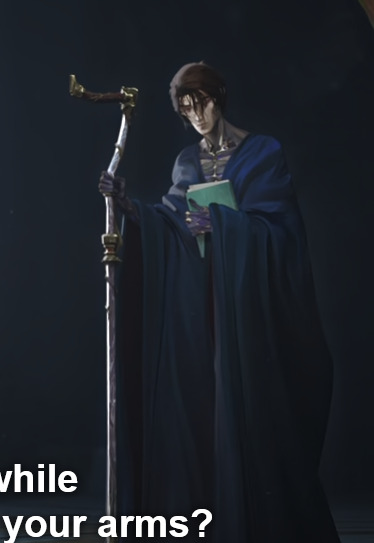
i'm not really sure what this is meant to mean tbh. st paul is the patron of missionaries, and is known for being influential in spreading catholicism, so maybe it's a reference to how viktor is going to spread hextech, or his own beliefs to his followers?
4.) light and halos are both incredibly important in catholic art and imagery. jesus, as well as saints and other important figures, are often depicted with circular halos around their heads, like angels. light is also often used as a symbol for god's knowledge or favor being shed on someone. in a ton of viktor's scene's, he is visibly more lit up than other people on screen, and there is this scene where he appears to have a halo, which a lot of people have pointed out.

if i see any more, i will add more to this!
19 notes
·
View notes
Text

The Return of the Prodigal Son (1669) 🎨 Rembrandt 🏛️ The State Hermitage Museum 📍 St. Petersburg, Russia
In the Gospel According to Luke (15: 11-32), Christ relates the parable of the prodigal son. A son asks his father for his inheritance and leaves the parental home, only to fritter away all his wealth. Arriving at last at sickness and poverty, he returns to his father's house. The old man is blinded by tears as he forgives his son, just as God forgives all those who repent. This parable in Rembrandt's treatment is addressed to the heart of everyone: "We should be glad: for this son was dead, and is alive again; and was lost, and is found.
This whole work is dominated by the idea of the victory of love, goodness and charity. The event is treated as the highest act of human wisdom and spiritual nobility, and it takes place in absolute silence and stillness. The drama and depth of feeling are expressed in the figures of both father and son, with all the emotional precision with which Rembrandt was endowed. The broad, sketchy brushstrokes of the artist's late style accentuate the emotion and intensity of this masterly painting.
#The Return of The Prodigal Son#Rembrandt#1669#religious painting#oil painting#painting#oil on canvas#dutch#Rembrandt Harmensz van Rijn#Baroque#Dutch Golden Age#Tenebrism#art#artwork#art history#The State Hermitage Museum#St. Petersburg#Russia#De terugkeer van de verloren zoon
19 notes
·
View notes
Text


Happy feast of Saint Luke the evangelist ☦❤
Born in Antioch, he witnessed Christ's miracles and listened to His preaching, and decided to follow Him. He was one of the 70 apostoles and was sent to spread the gospel. He wrote the Gospel at the request of other christians in his sixties. He is considered the founder of icon painting, painted three icons of Theotokos, who he met, and icons of St. apostoles Peter and Paul. At 84., idolaters hanged him for Christs sake in city of Thebes in Boeotia. His relicts were transfered to Constantinople during the reign of emperor Constantius.
#orthodoxy#orthodox christianity#eastern orthodoxy#orthodox#eastern orthodox#orthodox church#christianity#orthodox christian#church
80 notes
·
View notes
Text

The Four Evangelists
Artist: Peter Paul Rubens (Flemish, 1577 - 1640)
Date: c. 1625
Medium: Oil on canvas
Collection: The John and Mable Ringling Museum of Art, Sarasota, Florida, United States
Description
Rubens' painting of The Four Evangelists displays a group of figures in motion. At the far left is St. Luke with his ox, symbolic of sacrifice. This beast is traditionally an attribute of Luke, since his Gospel begins with the sacrifice of Zachariah. Next to Luke is St. Mark, his Gospel under his arm. At his side walks the lion that alludes to the Christ of the Resurrection. St. Matthew and the angel are given a central place. With one hand, the angel points to a gospel passage; with the other, he gestures heavenward, reflecting the divine inspiration with which Matthew wrote his Gospel. St. John the youngest of the group, looks up at an eagle. The eagle, thought to be able to look directly into the sun, denotes John's vision of the Apocalypse. The cup with the snake refers to poison that John drank, proving his faith.
#painting#oil on canvas#the four evangelists#christianity#flemish culture#artwork#fine art#christian art#flemish painter#symbolism#apostle luke#ox#apostle mark#book#lion#apostle matthew#angel#gospel passage#apostle john#eagle#cup#snake#christian faith#biblical art#oil painting#peter paul rubens#european art#17th century painting#the john and mable ringling museum of art
21 notes
·
View notes